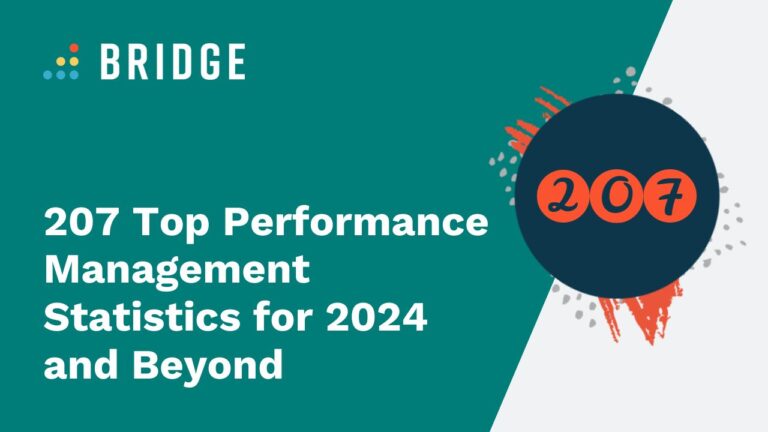Are you up to speed on the latest performance management trends? If you want the inside scoop on the changing attitudes and approaches toward performance management processes, technologies, and outcomes (or if you’re just a fan of HR statistics!) we’ve got you covered.
In 2023, Bridge sponsored an extensive report on the future of performance management. Conducted by HR.Research Institute, the report draws on insights from hundreds of HR professionals across most industry verticals. The result? 207 statistics on performance management, ranging from common performance processes to best practices for keeping managers accountable.
To extract a further layer of insight from the data, we sometimes pause to look at the disparities between two groups: performance management leaders and performance management laggards.
Performance leaders are respondents whose performance management processes allow them to achieve all their performance management goals to a high or very high degree. By contrast, “performance laggards” refers to respondents whose performance management processes only allow them to achieve their performance goals to a moderate, low, or very low degree—or even not at all.
There’s plenty of insight to go around—so let’s dive into the top performance management statistics you need to know.
The State of Key Performance Management Indicators in 2023
For many business leaders, performance management comes with a simple question: does it deliver results? The answer is undoubtedly “yes”—but our statistics on performance management show that there’s been a real decline across various performance management indicators when compared to 2022 figures. Take a look:
- In 2022, 44% of HR professionals said their organization’s performance management process had the ability to meet all organizational performance management goals, compared to 34% in 2023
- In 2022, 44% of HR professionals said their organization’s performance management process improved employee performance, compared to 33% in 2023
- In 2022, 32% of HR professionals said their organization’s performance management process improved employee retention, compared to 24% in 2023
- In 2022, 39% of HR professionals said their organization’s performance management process improved corporate culture, compared to 32% in 2023
- In 2022, 35% of HR professionals said their organization’s performance management process led to better employee development, compared to 28% in 2023
- In 2022, 37% of HR professionals said their organization’s performance management process increased employee engagement, compared to 31% in 2023
- In 2022, 34% of HR professionals said their organization’s performance management process led to better risk management, compared to 28% in 2023
- In 2022, 30% of HR professionals said their organization’s performance management process improved the distribution of rewards, compared to 23% in 2023
How Does the Data Change for Performance Management Leaders?
So, what does the above data look like when you compare leaders to laggards? Unsurprisingly, leaders are doing much better:
- 67% of performance management leader organizations experienced improved employee performance in 2023, compared to 16% of performance laggards
- 60% of performance management leader organizations experienced better employee development in 2023, compared to 16% of performance laggards
- 60% of performance management leader organizations experienced improved corporate culture in 2023, compared to 14% of performance laggards
- 51% of performance management leader organizations experienced increased employee engagement in 2023, compared to 15% of performance laggards
- 47% of performance management leader organizations experienced better risk management in 2023, compared to 18% of performance laggards
- 43% of performance management leader organizations experienced an improved distribution of rewards in 2023, compared to 14% of performance laggards
- 41% of performance management leader organizations experienced improved employee retention in 2023, compared to 15% of performance laggards
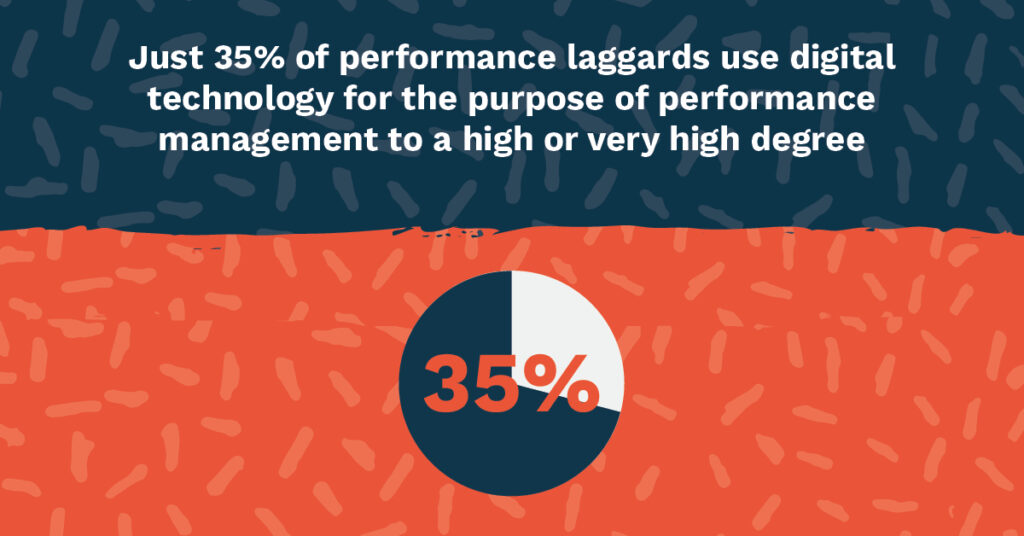
How Prevalent Is Performance Management Technology?
Whether we’re talking about performance reviews or continuous feedback, technology has the power to supercharge performance processes—but are organizations using solutions like performance management systems to their fullest?
The report asked respondents: “To what degree does your organization use any type of digital technology for the purpose of performance management?”—and here’s what they had to say:
- 14% of organizations use digital technology for performance management purposes to a very high degree
- 28% of organizations use digital technology for performance management purposes to a high degree
- 17% of organizations use digital technology for performance management purposes to a moderate degree
- 21% of organizations use digital technology for performance management purposes to a small degree
- 20% of organizations don’t use digital technology for performance management purposes
Larger Organizations Are More Likely to Use Performance Management Technology to a High Degree
Unsurprisingly, larger organizations—perhaps those with more budgetary resources or a larger workforce to accommodate—are more likely to use solutions like performance management software. Here’s the breakdown:
- 21% of smaller organizations use performance management technology to a high or very high degree
- 48% of mid-size organizations use performance management technology to a high or very high degree
- 52% of larger organizations use performance management technology to a high or very high degree
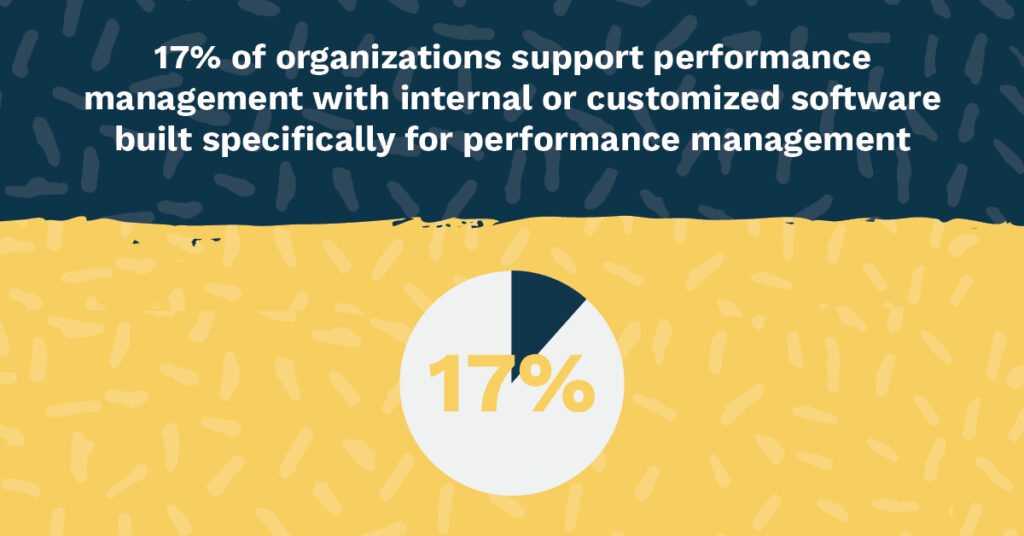
Ranked: The Most Common Technologies Used to Support Performance Management
So, a fair proportion of organizations use performance management software or similar technologies—especially leaders and larger entities. But what kind of technologies are in play? Here’s the spread:
- 51% of organizations support performance management with modules bundled into their HRIS/HRMS
- 27% of organizations support performance management with Excel, Access, or similar spreadsheet or database programs
- 17% of organizations support performance management with internal or customized software built specifically for performance management
- 17% of organizations support performance management with standalone or single-point solutions
- 10% of organizations support performance management through means not described above
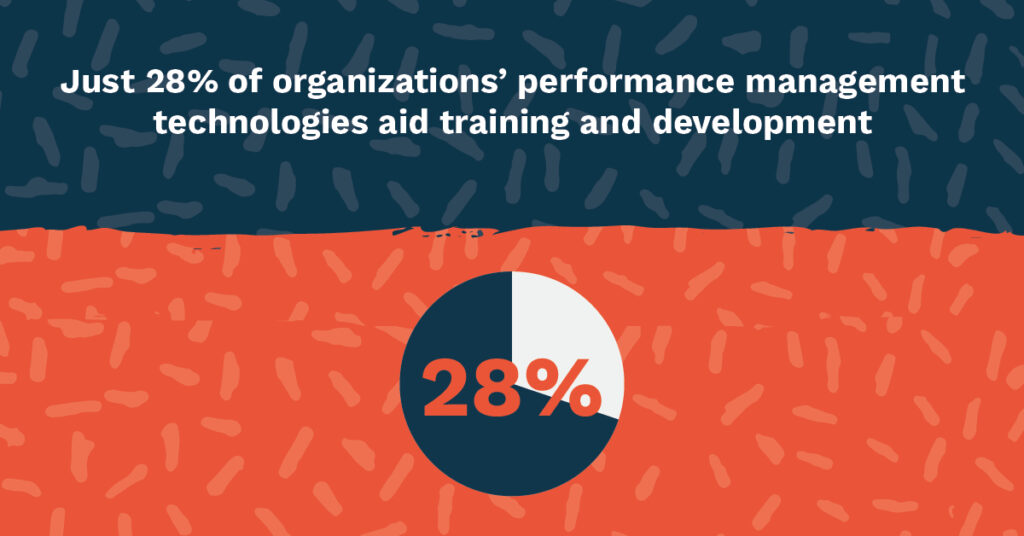
What Performance Management Skills Do Managers Hold?
Managers don’t just tell their reports to complete performance activities. In fact, managers are essential participants in those activities—but are they able to participate effectively?
Our respondents were given a series of statements about most managers at their organizations. Based on the proportion of respondents who responded “agree” or “strongly agree”, our key insights run as follows:
- In 39% of organizations, managers are good at helping employees set goals
- In 31% of organizations, managers have received sufficient training in performance management
- In 30% of organizations, managers are good at having conversations about workplace performance and behaviors
- In 29% of organizations, managers are satisfied with their performance management system
- In 23% of organizations, managers are skilled at performance management
Performance Management Trend: Skills and Training Are More Common Among Leader Organizations
When you compare performance leaders with their laggard counterparts, a clear pattern emerges: managers in leader organizations are much more likely to have the right skills and training. Here’s how the data plays out:
- 62% of performance management leaders think their managers are good at helping employees set goals, compared to 30% of performance laggards
- 46% of performance management leaders think their managers are good at having conversations about workplace performance and behaviors, compared to 26% of performance laggards
- 45% of performance management leaders think their managers have received sufficient training in performance management, compared to 25% of performance laggards
- 45% of performance management leaders think their managers are satisfied with their organization’s performance management system, compared to 21% of performance laggards
- 39% of performance management leaders think their managers are skilled at performance management, compared with 16% of performance laggards
MORE BRIDGE INSIGHTS | ‘Top Trends in Learning Technologies’
Performance Management Frequency: How Often Do 5 Key Performance Actions Take Place?
Though performance reviews tend to remain an annual event, the statistics show that supervisor-employee conversations and feedback occur on at least a quarterly basis. Let’s take a look:
Performance Activity 1) Formal Performance Reviews or Appraisals
Though performance reviews tend to remain an annual event, the statistics show that supervisor-employee conversations and feedback occur on at least a quarterly basis. Let’s take a look:
- 10% of organizations undertake formal performance reviews or appraisals less than once a year
- 58% of organizations undertake formal performance reviews or appraisals once a year
- 21% of organizations undertake formal performance reviews or appraisals twice a year
- 12% of organizations undertake formal performance reviews or appraisals four times or more a year
Performance Activity 2) Supervisor and Employee Conversations About Performance
- 8% of organizations hold supervisor and employee conversations about performance less than once a year
- 22% of organizations hold supervisor and employee conversations about performance once a year
- 19% of organizations hold supervisor and employee conversations about performance twice a year
- 55% of organizations hold supervisor and employee conversations about performance four times or more a year
Performance Activity 3) Supervisor and Employee Conversations About Career Goals
- 21% of organizations hold supervisor and employee conversations about career goals less than once a year
- 28% of organizations hold supervisor and employee conversations about career goals once a year
- 21% of organizations hold supervisor and employee conversations about career goals twice a year
- 27% of organizations hold supervisor and employee conversations about career goals four times or more a year
Performance Activity 4) Work-Related Feedback Between Supervisors and Employees
- 8% of organizations gather work-related feedback between supervisors and employees less than once a year
- 13% of organizations gather work-related feedback between supervisors and employees once a year
- 12% of organizations gather work-related feedback between supervisors and employees twice a year
- 69% of organizations gather work-related feedback between supervisors and employees four times or more a year
Performance Activity 5) Peer-to-Peer Feedback
- 57% of organizations gather peer-to-peer feedback less than once a year
- 5% of organizations gather peer-to-peer feedback once a year
- 5% of organizations gather peer-to-peer feedback twice a year
- 27% of organizations gather peer-to-peer feedback four times or more a year
Performance Leaders Are More Likely to Take Quarterly Performance Actions
Compared to the organizations our report classes as performance laggards, leaders tend to conduct a number of performance-related actions on a more regular basis. Among respondents who responded “quarterly or more frequently”, here’s how the data looks:
- 70% of performance management leaders conduct work-related feedback between supervisors and employees on at least a quarterly basis—compared to only 55% of laggards
- 60% of performance management leaders conduct supervisor-employee conversations about performance on at least a quarterly basis—compared to only 46% of laggards
- 33% of performance management leaders conduct supervisor-employee conversations about goals on at least a quarterly basis—compared to only 17% of laggards
- 24% of performance management leaders conduct formal performance reviews or appraisals on at least a quarterly basis—compared to only 6% of laggards
Key Performance Management Statistics Around Tech Capabilities
There may be a variety of performance management technologies to choose from, but what do they actually do? Here’s the lowdown:
- 63% of organizations’ performance management technologies include performance appraisal ratings
- 62% of organizations’ performance management technologies facilitate the employee performance review or appraisal process
- 58% of organizations’ performance management technologies allow users to evaluate performance in relation to goals
- 51% of organizations’ performance management technologies permit automated reminders
- 48% of organizations’ performance management technologies allow workflow approvals
- 44% of organizations’ performance management technologies track performance review meetings
- 42% of organizations’ performance management technologies enable one-on-ones and/or check-ins between managers and employees
- 29% of organizations’ performance management technologies enable 360-degree feedback between managers, employees, and peers
- 28% of organizations’ performance management technologies aid training and development
- 28% of organizations’ performance management technologies enable recognition/praise by others
- 23% of organizations’ performance management technologies aid communication
- 19% of organizations’ performance management technologies include a calibration process
- 16% of organizations’ performance management technologies can integrate with third-party solutions (16%)
- 7% of organizations’ performance management technologies don’t include any of the capabilities described above
INVEST IN THE RIGHT PERFORMANCE TECH | ‘Power Up Your Performance Management With Bridge’
A Deeper Dive Into Performance Management Integration
While only 16% of respondents said their performance management technology could integrate with third-party solutions, there’s still a notable variance at play between leaders and laggards. According to the data:
- 23% of performance management leaders said their technology can integrate with third-party solutions
- Just 12% of performance management laggards said their technology can integrate with third-party solutions
Further Key Features of Performance Management Technologies
In addition to the capabilities named above, our respondents were also given a list of additional features and asked to select every feature their performance-related technologies included. Here’s the result:
- 54% of organizations’ performance technology provides timely reminders to managers
- 53% of organizations’ performance technology permits managers to add notes at any time
- 48% of organizations’ performance technology permits employees to add notes at any time
- 34% of organizations’ performance technology tracks training and development achievements
- 30% of organizations’ performance technology allows for the recognition of employee achievements
- 18% of organizations’ performance technology makes training and development suggestions
- 13% of organizations’ performance technology allows rewards for employee achievements
- 16% of organizations’ performance technology is unable to perform the functions described above
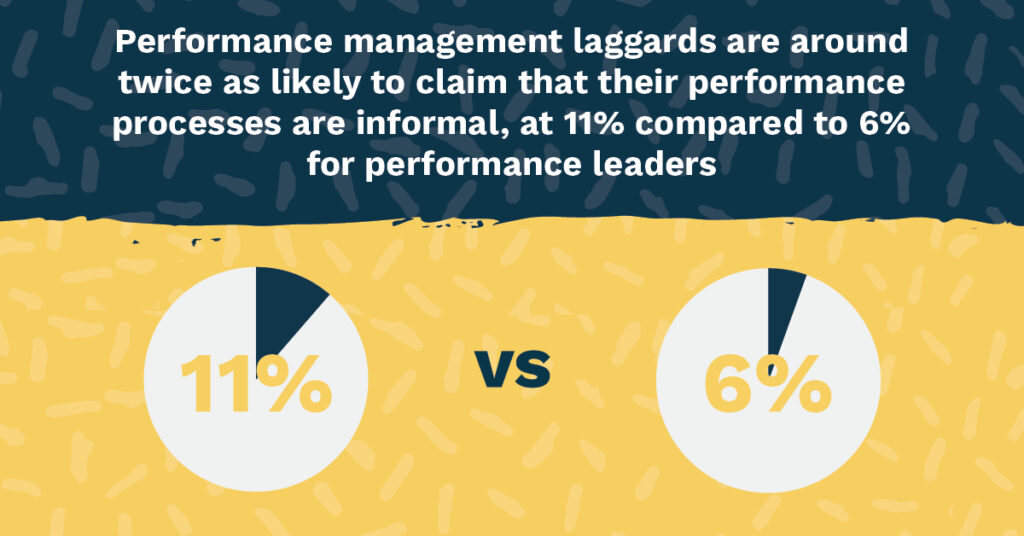
The Extent to Which Performance Management Programs Are Formalized and Structured
Performance management isn’t just about the tech: it’s equally about the processes.
When asked whether or not their organization has a performance management process, our survey participants responded as follows:
- 48% of organizations have a structured and formalized performance management process
- 37% of organizations have a performance management process that includes both formal and informal elements
- 9% of organizations have an entirely informal performance management process with no formalized elements
- 6% of organizations have no performance management process at all
RELATED READING | ‘How to Create a Performance Management Plan’
Here’s How Organization Size Impacts Structured Performance Management Processes
Organization size has a substantial bearing on the form performance management takes. According to our performance management statistics, the likelihood of having a formal performance management process runs as follows:
- 55% of larger organizations have a structured performance management process
- 40% of mid-sized organizations have a structured performance management process
- 30% of smaller organizations have a structured performance management process
By a similar token, having a performance management process with more informal elements gets more likely the smaller your organization is. According to the report:
- 17% of smaller organizations have a performance management process with informal elements
- 4% of mid-size organizations have a performance management process with informal elements
- 5% of larger organizations have a performance management process with informal elements
Performance Management Leaders Are More Likely to Have a Structured Process
Our data suggests that leaders in the world of performance management tend to formalize their performance management processes:
- 57% of performance management leaders have a structured and formalized performance process
- Just 43% of performance management laggards have a structured performance management process
- Performance management laggards are around twice as likely to claim that their performance processes are informal, at 11% compared to 6% for performance leaders
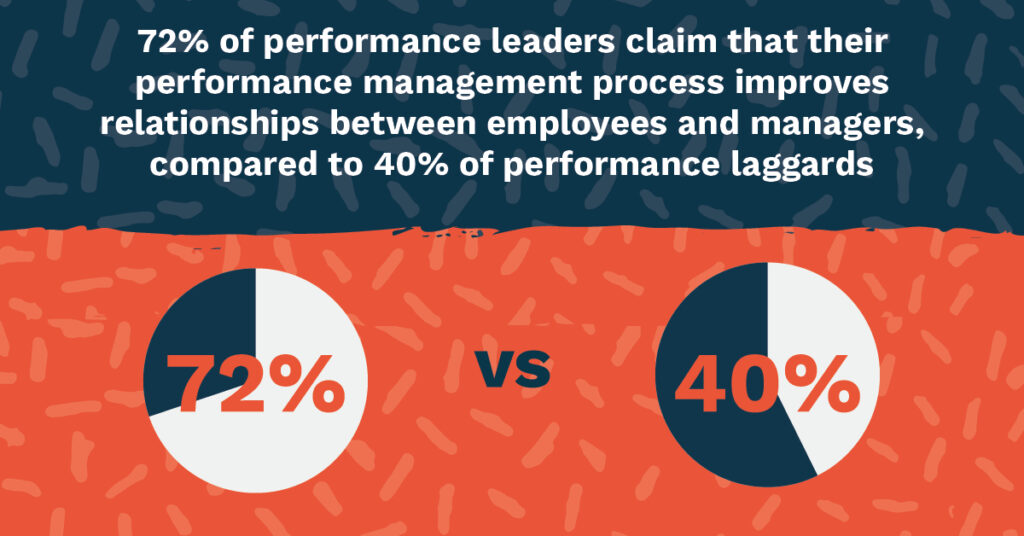
Performance Management Processes Ranked
Levels of formality may vary, but no matter what form the performance process takes, there are a handful of pretty common attributes that many organizations’ approaches share.
So, what do those attributes look like? Here’s what our respondents said:
- 73% of organizations have a performance management process that includes both positive and negative feedback and constructive critique
- 73% of organizations have a performance management process that includes a discussion of work goals
- 66% of organizations have a performance management process that involves a conversation about developmental goals and activities
- 50% of organizations have a performance management process that improves relationships between managers and employees
- 47% of organizations have a performance management process that’s easy to understand
- 47% of organizations have a performance management process that’s easy to use
- 45% of organizations have a performance management process that allows for continuous feedback
- 30% of organizations have a performance management process that accurately portrays employee performance
Performance Process Insights by Organization Size
There are some pretty notable divergences in some of these characteristics based on organization size. Let’s take a look:
- 60% of smaller organizations allow for continuous feedback, compared to 38% of mid-size organizations and 41% of larger organizations
- 63% of smaller organizations say performance processes improve relationships between managers and employees, compared to 54% of mid-size organizations and just 39% of larger organizations
Why Isn’t Performance Management Improving Employee-Manager Relationships?
The 50% of respondents who didn’t agree that their performance management process improves relationships between managers and employees were asked to elaborate. Here’s what they said:
- For 68% of organizations, performance management was seen as an obligation to just get through
- For 64% of organizations, managers lack good skills in the performance management area
- For 14% of organizations, employees don’t like constructive feedback
- For 11% of organizations, performance appraisals are too threatening
KEEP READING | ‘Are Perceptions of Performance Management Getting More Negative?’
Key Performance Management Trend: Leader Organizations Are Twice as Likely to Feel Their Process Accurately Portrays Employee Performance
This isn’t the most surprising piece of data to come out of this breakdown of our performance management statistics. Still, it’s well worth noting that the organizations that see the most success with their performance management goals are much more likely to feel that their performance management process gives a good sense of employee performance.
- 72% of performance leaders claim that their performance management process improves relationships between employees and managers, compared to 40% of performance laggards
- 59% of performance leaders claim that their performance management process allows for continuous feedback, compared to 40% of laggards
- 56% of performance leaders claim that their performance management process is easy to use, compared to 44% of performance laggards
- 55% of performance leaders claim that their performance management process is easy to understand, compared to 44% of performance laggards
- 48% of performance leaders claim that their performance management process accurately portrays employee performance, compared to just 24% of performance laggards
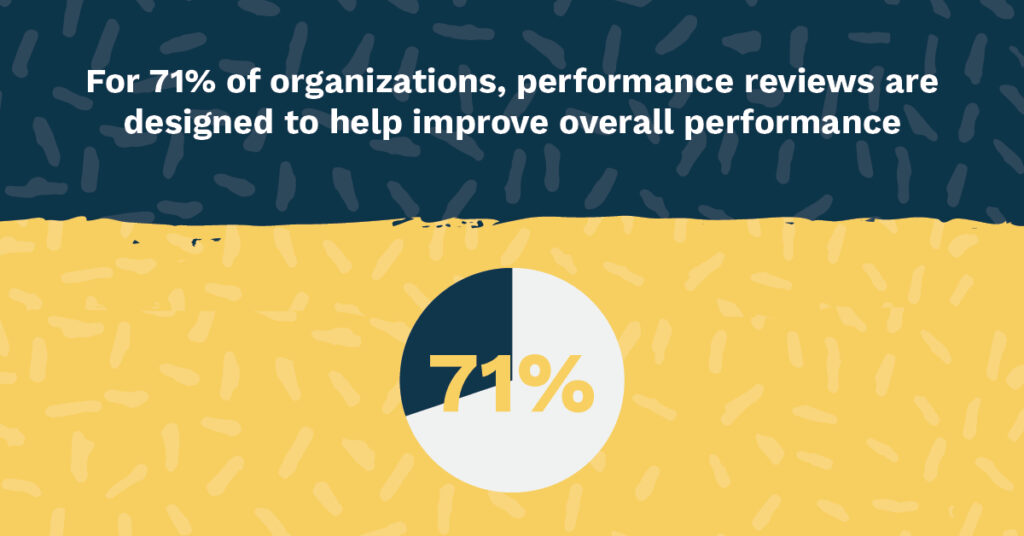
Performance Management Trend: Ranking The Primary Objectives of Performance Reviews
Why do organizations undertake performance reviews? What kind of outcomes are they looking to achieve? This was a varied picture, with sentiment toward helping individual employees playing second fiddle to employee-manager communication boosts and an emphasis on improving overall organizational performance.
When asked: “which of the following are objectives your organization’s performance reviews are designed to achieve?”, respondents answered as follows:
- For 71% of organizations, performance reviews are designed to help improve overall performance
- For 68% of organizations, performance reviews are designed to boost communication between employees and managers
- For 66% of organizations, performance reviews are designed to help individual employees learn and grow
- For 62% of organizations, performance reviews are designed to boost the individual performance of an employee
- For 55% of organizations, performance reviews are designed to increase employee engagement
- For 53% of organizations, performance reviews are designed to identify barriers to employees at work
- For 49% of organizations, performance reviews are designed to meet organizational requirements
- For 42% of organizations, performance reviews are designed to facilitate performance-related changes in pay
- For 41% of organizations, performance reviews are designed to increase employee retention
- For 39% of organizations, performance reviews are designed to have a legal record of interactions with employees
- For 35% of organizations, performance reviews are designed to force a conversation about poor performance
- For 28% of organizations, performance reviews are designed to justify dismissing low-performing employees
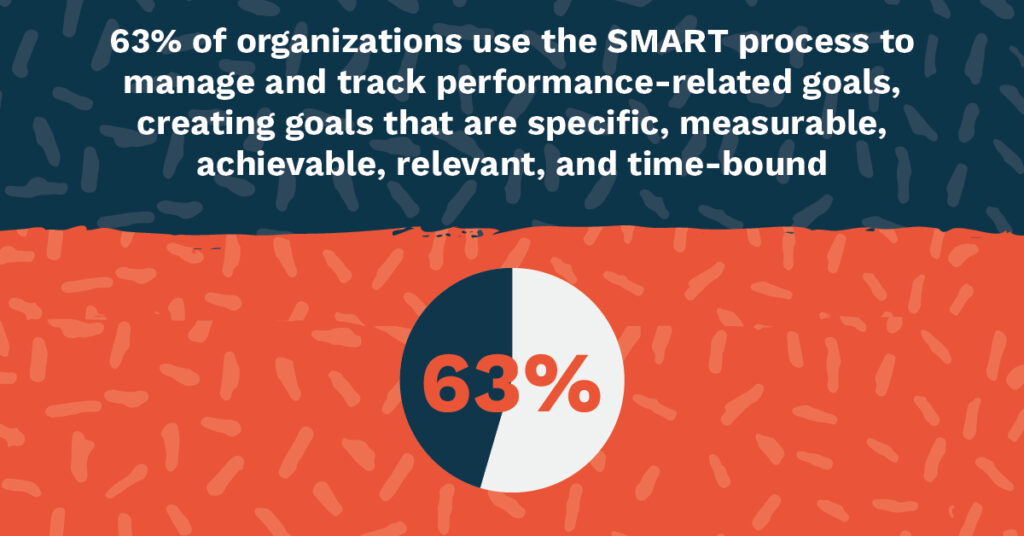
How Are Organizations Managing and Tracking Performance-Related Goals?
Goals are the backbone of performance management—but how do organizations monitor performance goals? Once again, our performance management statistics have something to show:
- 63% of organizations use the SMART process to manage and track performance-related goals, creating goals that are specific, measurable, achievable, relevant, and time-bound
- 38% of organizations use KPIs (key performance indicators) to manage and track performance-related goals
- 20% of organizations use OKRs (objectives and key results) to manage and track performance-related goals
These aren’t the only goals covered in the report, but they’re the most statistically significant. A smattering of respondents used alternatives:
- 15% of organizations use methods specific to their performance modules or systems to manage and track performance-related goals
- 13% of organizations use management by objective, or MBO, to manage and track performance-related goals
- 11% of organizations use key result areas, or KRAs, to manage and track performance-related goals
- 10% of organizations use agile goal setting to manage and track performance-related goals
- 9% of organizations use progress, plans, and problems, or PPPs, to manage and track performance-related goals
- 5% of organizations use behaviorally anchored rating scales, or BARS, to manage and track performance-related goals
- 2% of organizations use an assessment center method to manage and track performance-related goals
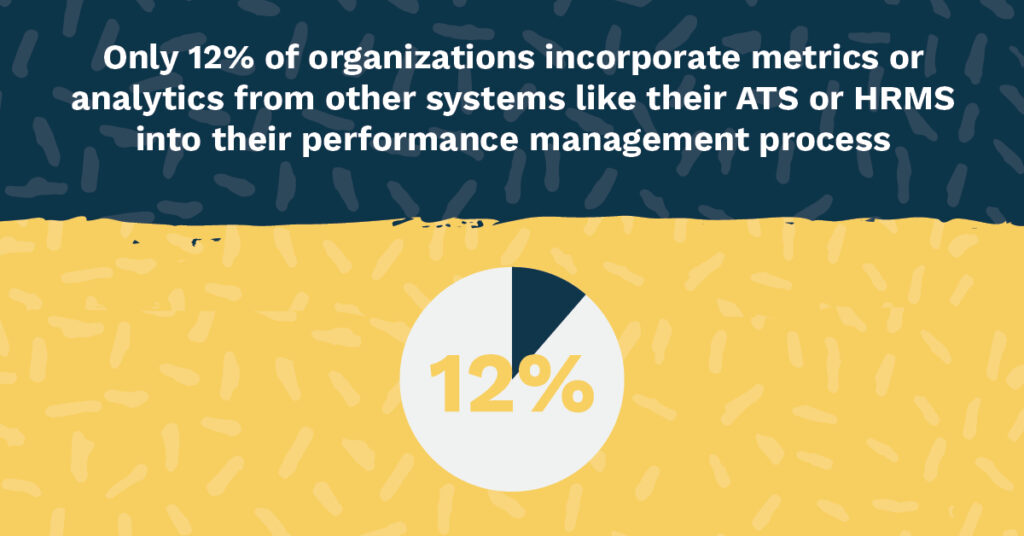
Metrics That Matter in the Performance Management Process
The achievement of these goals can be a good way to measure performance—but they’re not the only metric on offer. Here’s the full breakdown of our respondents’ favorite options:
- 67% of organizations use manager ratings in their performance management process
- 55% of organizations incorporate self-ratings into their performance management process
- 54% of organizations incorporate goal achievement metrics into their performance management process
- 28% of organizations incorporate behavior-related scores into their performance management process
- 17% of organizations incorporate non-forced rankings into their performance management process
- 14% of organizations incorporate 360 feedback into their performance management process
- 13% of organizations incorporate customer feedback into their performance management process
- 12% of organizations incorporate metrics or analytics from other systems like their ATS or HRMS into their performance management process
- 9% of organizations incorporate forced rankings into their performance management process
- 8% of organizations incorporate engagement scores into their performance management process
- 8% of organizations incorporate peer ratings into their performance management process
- 6% of organizations incorporate net promoter scores into their performance management process
- 4% of organizations incorporate social recognition scores into their performance management process
- 3% of organizations incorporate employee sentiment scores into their performance management process
- 9% of organizations don’t incorporate any metrics into their performance management process
MORE ABOUT METRICS | ‘Learning Analytics: 4 Essential Metrics and Strategies for L&D Success’
How Are Managers Kept Accountable for Performance Activities?
No matter how you measure the success of your performance management programs, you’ll only see good outcomes if your performance activities are enforced by managers. So, how are organizations encouraging managers to enact performance processes?
While over a quarter of organizations don’t name any particular method for keeping managers accountable, a swathe of respondents had something to say on the subject. Here’s what we learned:
- 56% of organizations hold managers accountable for completing performance management activities by tracking formal appraisals between managers and employees
- 22% of organizations keep managers accountable for completing performance management activities by incorporating the performance process into their KPIs
- 18% of organizations keep managers accountable for completing performance management activities by tying compensation rates, bonuses, and similar monetary rewards to the completion of those activities
- 13% of organizations keep managers accountable for completing performance management activities by tracking manager-employee coaching and/or conversations
- 12% of organizations keep managers accountable for completing performance management activities by keeping track of the engagement and/or retention rates of managers’ direct reports
- 9% of organizations keep managers accountable for completing performance management activities by asking direct reports to fill out a manager feedback survey annually
- 8% of organizations keep managers accountable for completing performance management activities by asking employees to rate managers by (among other things) how well they manage performance
- 27% of organizations don’t hold managers accountable for completing performance management activities in any particular way
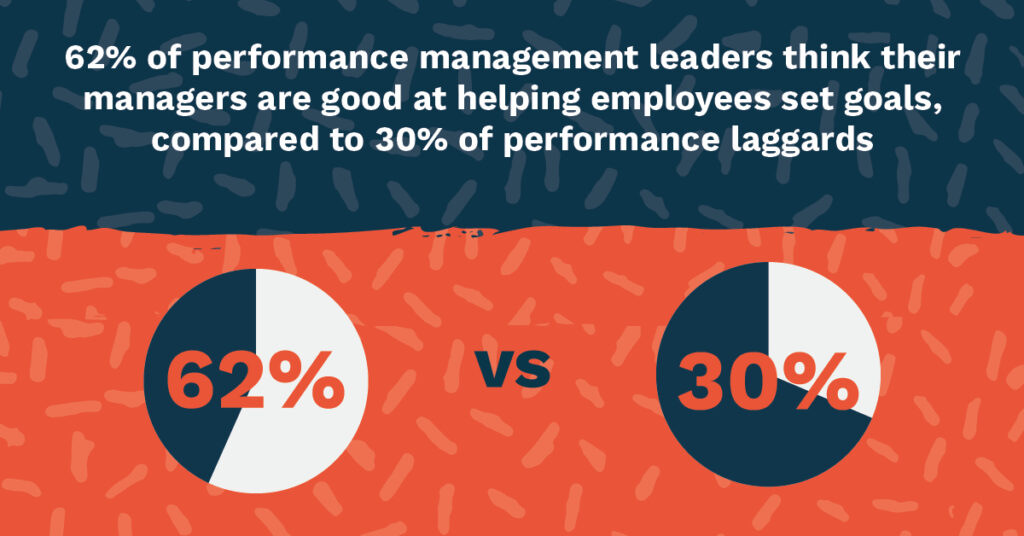
The C-Suite Perspective on Performance Management
When it comes to performance management, the buck doesn’t stop with managers. Top-level individuals can have a huge degree of influence over the performance management process—but they don’t all approach the subject with enthusiasm.
When asked how senior leaders view performance management, respondents said:
- 34% of senior leaders view performance management as a necessary evil
- 15% of senior leaders view performance management as an aid to employee development
- 15% of senior leaders view performance management as a means to improve engagement and/or retention
- 13% of senior leaders view performance management as crucial for overall business performance
- 13% of senior leaders view performance management as an effective way to make employee-related decisions
- 6% of senior leaders view performance management as an unnecessary waste of time
Here’s How the Stats Change Among Performance Management Leaders
Across these statistics about performance management, there’s often a distinction between performance leaders and performance laggards—and the attitudes toward the subject from senior figures is no exception. Not a single performance leader in the report suggested that senior figures view performance management as a waste of time, and very few described it as a necessary evil, either.
Want a little more detail? Here’s how the “leaders vs laggards” comparison looks up close:
- In 29% of performance leader organizations, top-level figures view performance management as an aid to employee development, compared to just 9% of performance laggards
- In 18% of performance leader organizations, top-level figures view performance management as crucial for overall business performance, compared to just 10% of performance laggards
- In 16% of performance leader organizations, top-level figures view performance management as a necessary evil, compared to an enormous 42% of performance laggards
- Zero performance leader organizations feel that top-level figures view performance management as an unnecessary waste of time, compared to 11% of performance laggards
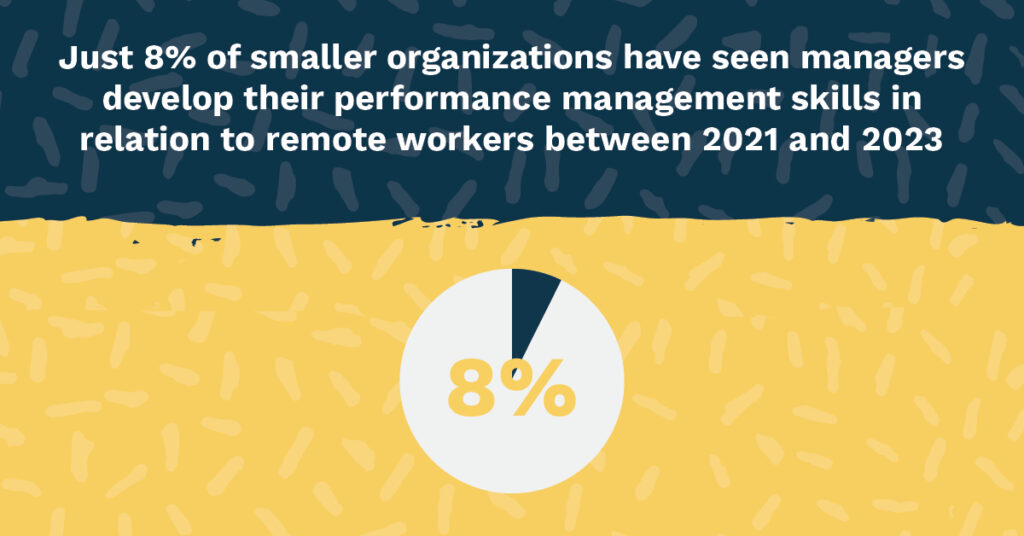
Recent Performance Management Trends
Does performance management sit still? Or is it a dynamic field, reacting to changing organizational needs?
Around a third of respondents reported changes in how (and how often) performance activities are carried out. Let’s take a look at what our performance management statistics say:
- Between 2021 and 2023, 32% of organizations have seen an increase in scheduled one-to-one meetings
- Between 2021 and 2023, 32% of organizations have given employees greater input into performance management goals
- Between 2021 and 2023, 31% of organizations have seen an increase in managers conducting performance discussions remotely rather than face-to-face
- Between 2021 and 2023, 30% of organizations have seen an increase in managers touching on issues aside from performance (like wellbeing)
- Between 2021 and 2023, 28% of organizations have seen managers work harder to align employee personal goals with business objectives
- Between 2021 and 2023, 17% of organizations have seen their performance appraisals become more reciprocal and/or multi-rater
- Between 2021 and 2023, 16% of organizations have seen managers develop their performance management skillsets for remote workers
- Between 2021 and 2023, 11% of organizations have seen performance management become more project-based
- 22% of organizations experienced no changes to performance management between 2021 and 2023
Performance Management Trend: Smaller Organizations Have More One-on-One Employee-Manager Meetings
Again, size has a bearing on the changing performance practices at play here. In particular, the likelihood of an increase in one-on-ones is much higher among smaller and mid-size organizations—possibly because they have fewer employees to organize. Here’s the detail:
- 42% of smaller organizations indicate that managers scheduled more one-on-one meetings between 2021 and 2023
- 42% of mid-size organizations also indicate that managers scheduled more one-on-one meetings between 2021 and 2023
- Only 23% of larger organizations experienced an uptick in manager-scheduled one-on-ones between 2021 and 2023
That’s not to say that larger organizations aren’t leading the way in other areas of performance management change. There’s a small but significant gap to be found when it comes to the performance management skills managers hold when it comes to remote workers:
- 23% of larger organizations have seen managers develop their performance management skills in relation to remote workers between 2021 and 2023
- 16% of mid-sized organizations have seen managers develop their performance management skills in relation to remote workers between 2021 and 2023
- Just 8% of smaller organizations have seen managers develop their performance management skills in relation to remote workers between 2021 and 2023
Looking Ahead: The Future of Performance Management
Some organizations may have seen some changes to their performance management playbooks in recent years, but that doesn’t mean it’s time to rest on their laurels. Our respondents had plenty of predictions for what’s next in the world of performance management:
- 58% of HR professionals expect performance management to include more frequent or continuous feedback between 2023 and 2025
- 55% of HR professionals expect performance management to include more manager training between 2023 and 2025
- 48% of HR professionals expect performance management to include more frequent and natural conversations between 2023 and 2025
- 47% of HR professionals expect performance management to become more focused on development activities between 2023 and 2025
- 46% of HR professionals expect performance management to become more aligned with business goals between 2023 and 2025
- 38% of HR professionals expect performance management to become better at boosting employee performance between 2023 and 2025
- 33% of HR professionals expect performance management to focus more on employee experience and wellbeing between 2023 and 2025
- 29% of HR professionals expect performance management to become more automated between 2023 and 2025
- 26% of HR professionals expect performance management to become more objective and data-based between 2023 and 2025
- 25% of HR professionals expect performance management to become increasingly based on verbal/written conversations rather than ratings between 2023 and 2025
- 24% of HR professionals expect performance management to become more integrated with employee engagement data between 2023 and 2025
- 19% of HR professionals expect performance management to become less formal and structured between 2023 and 2025
- 11% of HR professionals expect performance management to become more project-based between 2023 and 2025
- 7% of HR professionals expect that performance management won’t change between 2023 and 2025
- 4% of HR professionals expect performance management will increasingly disappear from the landscape between 2023 and 2025
MORE PERFORMANCE INSIGHTS | ‘10 Performance Management Trends Shaping HR in 2023’
Leading Performance Management Organizations Are Looking to Performance Technology for Employee Performance Boosts
Given their performance-related successes, the views of our performance management leader organizations are well worth considering when planning the next phase of your performance management journey.
Here are the two areas performance leaders are paying closer attention to than performance laggards:
- 53% of performance leader organizations say their performance technologies will become more aligned with business goals, compared to 44% of performance laggards
- 47% of performance leader organizations say their performance technologies will become better at boosting employee performance, compared to 34% of performance laggards
Get the Analysis Behind the Figures With Our Full Performance Management Report
These performance management statistics are just the start. Download the Bridge-sponsored Future of Performance Management Report for a deep dive into the significant insights and key takeaways of this comprehensive exploration of performance management.
Bridge’s performance management system is available as a standalone product or as part of Bridge’s award-winning LMS. Find out how Bridge’s performance management system can help you follow the performance trends that count by reaching out for a demo today.
